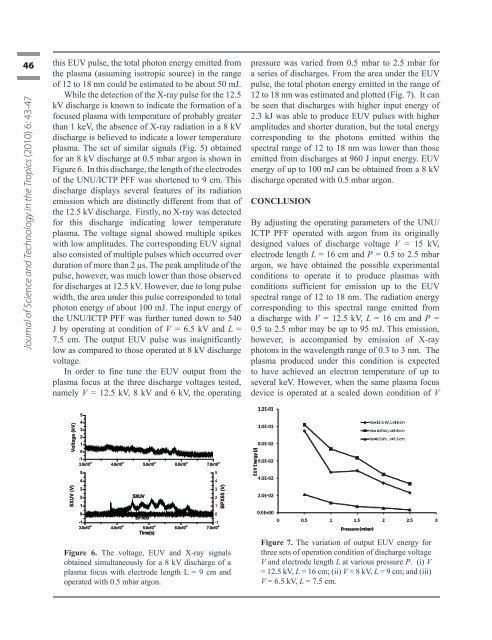Download - Akademi Sains Malaysia
Download - Akademi Sains Malaysia
Download - Akademi Sains Malaysia
Create successful ePaper yourself
Turn your PDF publications into a flip-book with our unique Google optimized e-Paper software.
46<br />
Journal of Science and Technology in the Tropics (2010) 6: 43-47<br />
this EUV pulse, the total photon energy emitted from<br />
the plasma (assuming isotropic source) in the range<br />
of 12 to 18 nm could be estimated to be about 50 mJ.<br />
While the detection of the X-ray pulse for the 12.5<br />
kV discharge is known to indicate the formation of a<br />
focused plasma with temperature of probably greater<br />
than 1 keV, the absence of X-ray radiation in a 8 kV<br />
discharge is believed to indicate a lower temperature<br />
plasma. The set of similar signals (Fig. 5) obtained<br />
for an 8 kV discharge at 0.5 mbar argon is shown in<br />
Figure 6. In this discharge, the length of the electrodes<br />
of the UNU/ICTP PFF was shortened to 9 cm. This<br />
discharge displays several features of its radiation<br />
emission which are distinctly different from that of<br />
the 12.5 kV discharge. Firstly, no X-ray was detected<br />
for this discharge indicating lower temperature<br />
plasma. The voltage signal showed multiple spikes<br />
with low amplitudes. The corresponding EUV signal<br />
also consisted of multiple pulses which occurred over<br />
duration of more than 2 µs. The peak amplitude of the<br />
pulse, however, was much lower than those observed<br />
for discharges at 12.5 kV. However, due to long pulse<br />
width, the area under this pulse corresponded to total<br />
photon energy of about 100 mJ. The input energy of<br />
the UNU/ICTP PFF was further tuned down to 540<br />
J by operating at condition of V = 6.5 kV and L =<br />
7.5 cm. The output EUV pulse was insignificantly<br />
low as compared to those operated at 8 kV discharge<br />
voltage.<br />
In order to fine tune the EUV output from the<br />
plasma focus at the three discharge voltages tested,<br />
namely V = 12.5 kV, 8 kV and 6 kV, the operating<br />
SXUV (V) Voltage (kV)<br />
5<br />
4<br />
3<br />
2<br />
1<br />
0<br />
-1<br />
3.0x10 -6<br />
5<br />
4<br />
3<br />
2<br />
1<br />
0<br />
-1<br />
3.0x10 -6<br />
4.0x10 -6<br />
4.0x10 -6<br />
SXUV<br />
BPX65<br />
5.0x10 -6<br />
5.0x10 -6<br />
Time(s)<br />
6.0x10 -6<br />
6.0x10 -6<br />
7.0x10 -6<br />
5<br />
4<br />
3<br />
2<br />
1<br />
0<br />
-1<br />
7.0x10 -6<br />
Figure 6. The voltage, EUV and X-ray signals<br />
obtained simultaneously for a 8 kV discharge of a<br />
plasma focus with electrode length L = 9 cm and<br />
operated with 0.5 mbar argon.<br />
BPX65 (V)<br />
pressure was varied from 0.5 mbar to 2.5 mbar for<br />
a series of discharges. From the area under the EUV<br />
pulse, the total photon energy emitted in the range of<br />
12 to 18 nm was estimated and plotted (Fig. 7). It can<br />
be seen that discharges with higher input energy of<br />
2.3 kJ was able to produce EUV pulses with higher<br />
amplitudes and shorter duration, but the total energy<br />
corresponding to the photons emitted within the<br />
spectral range of 12 to 18 nm was lower than those<br />
emitted from discharges at 960 J input energy. EUV<br />
energy of up to 100 mJ can be obtained from a 8 kV<br />
discharge operated with 0.5 mbar argon.<br />
CONCLUSION<br />
By adjusting the operating parameters of the UNU/<br />
ICTP PFF operated with argon from its originally<br />
designed values of discharge voltage V = 15 kV,<br />
electrode length L = 16 cm and P = 0.5 to 2.5 mbar<br />
argon, we have obtained the possible experimental<br />
conditions to operate it to produce plasmas with<br />
conditions sufficient for emission up to the EUV<br />
spectral range of 12 to 18 nm. The radiation energy<br />
corresponding to this spectral range emitted from<br />
a discharge with V = 12.5 kV, L = 16 cm and P =<br />
0.5 to 2.5 mbar may be up to 95 mJ. This emission,<br />
however, is accompanied by emission of X-ray<br />
photons in the wavelength range of 0.3 to 3 nm. The<br />
plasma produced under this condition is expected<br />
to have achieved an electron temperature of up to<br />
several keV. However, when the same plasma focus<br />
device is operated at a scaled down condition of V<br />
Figure 7. The variation of output EUV energy for<br />
three sets of operation condition of discharge voltage<br />
V and electrode length L at various pressure P. (i) V<br />
= 12.5 kV, L = 16 cm; (ii) V = 8 kV, L = 9 cm; and (iii)<br />
V = 6.5 kV, L = 7.5 cm.<br />
Jostt vol 6.indd 46 7/22/10 10:09:27 PM<br />

















